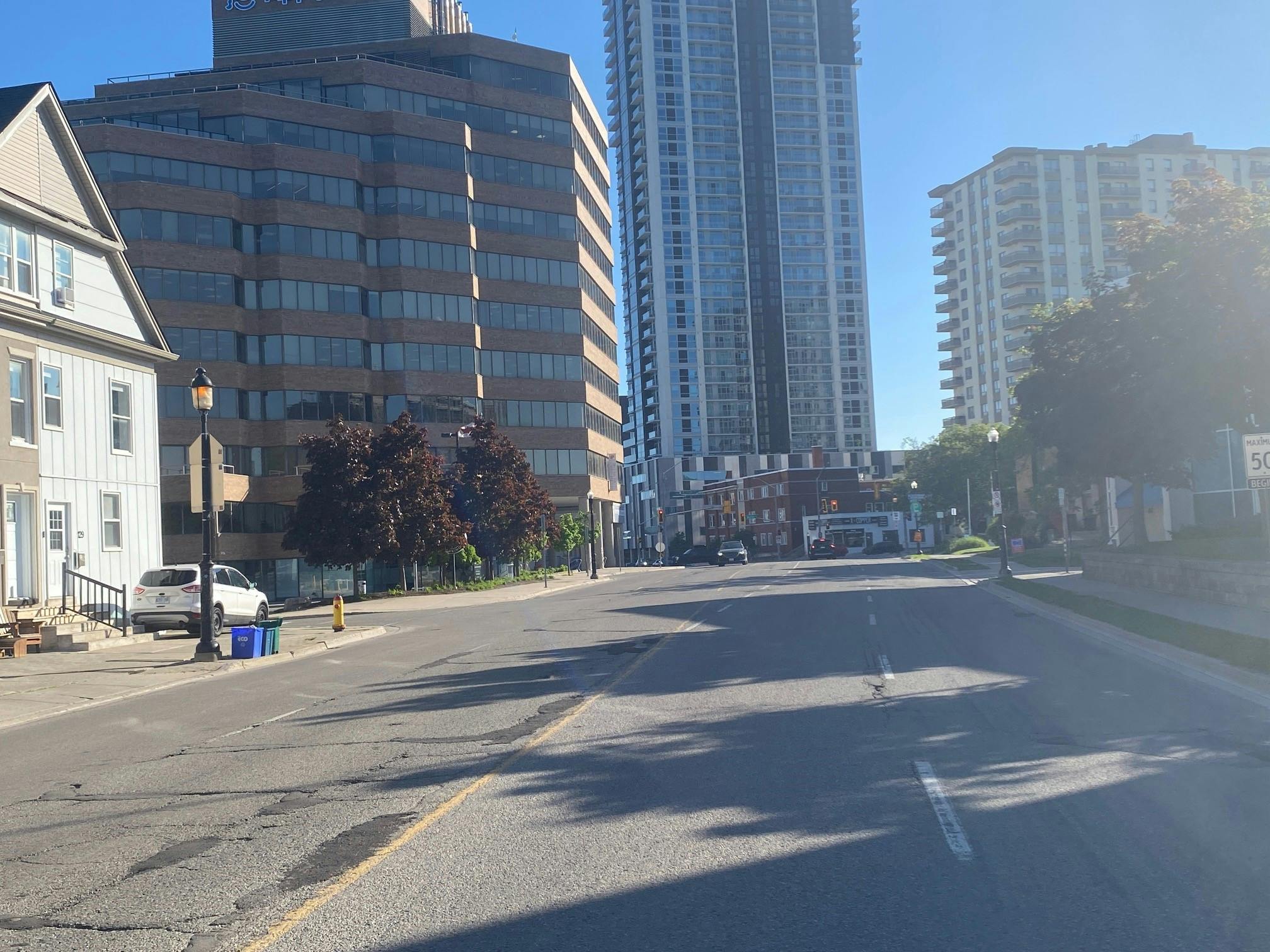FAQs
Why is the Region considering this project?
The 2018 Transportation Master Plan identified the need for cycling improvements in the Benton/Frederick corridor by 2031. Regional Council directed staff to analyze a submission for active transportation improvements developed by a member of the public https://betterbenton.netlify.app/ and at the April 12, 2022 meeting Council directed staff to develop a short-term implementation plan (Phase 1) in addition to the long-term plan (Phase 2) which will take place when the infrastructure in the corridor is reconstructed.
What is the project (Phase 1)?
The project includes single directional painted bicycle lanes along Benton Street between Courtland Avenue and Charles Street, and Frederick Street between Weber Street and Lancaster Street. The implementation of the cycling lanes will require the re-allocation of road space by reducing the number of vehicular lanes from four to two and the removal of parking along one side of Benton Street between Courtland Avenue and St George Street.
The addition of painted bicycle lanes along the section of Benton Street and Frederick Street between Charles Street and Weber Street has significant challenges and would not be operating effectively. The inclusion of cycling facilities along this section would require significant reconstruction, thus this project will be included in Phase 2. The functional design for Phase 2 is planned to commence later in 2024.
What are the benefits of this project?
The provision of cycling lanes will make cycling safer, improve equity by providing a mode of transportation for those who do not drive, provide an alternative to driving, provide cycling connection to LRT and thus increase the modal share of both cycling and transit. The improved cycling environment will make it easier for all road users to opt for climate-friendly mode choices. This project will also serve as a pilot study to Phase 2, which will be looking at developing a separated cycling facility (All Ages and Abilities - AAA) along the entire corridor and will connect to and expand the City of Kitchener’s downtown cycling network. This project connects to the City of Kitchener’s downtown cycling grid through the neighbourhood bikeway on Benton Street to the Iron Horse Trail. Project also connects to the separated bike lanes on Duke Street, neighbourhood bikeway on Church Street and multi-use trail on Otto Street, thus completing some of the missing links in cycling near the downtown.
What will be the impact of this project on Downtown Kitchener?
Downtown Kitchener and the Benton corridor has been intensifying with the addition of a number of high–rise residential buildings. Intensification can be successful only with low car use and increased walking, cycling, and transit travel. Benton Street-Frederick Street is a key corridor for transit and active transportation due to the close proximity to downtown and its retail businesses, restaurants, and other attractions. The developments along this corridor will generate more shorter trips which can be accommodated effectively by cycling or walking, as long as comfortable and safe transportation facilities are provided. Furthermore, fewer car trips will reduce air and noise pollution to residents living along the Benton-Frederick corridor and also help reduce greenhouse gas emissions.
What are the impacts of the road space re-allocation?
Potential for traffic diversion to other roadways
The traffic modelling exercises for Benton-Frederick Corridor were conducted as part of the 2018 Transportation Master Plan update (Moving Forward 2031).The results of the model indicate that a two-lane cross-section is adequate for accommodating the anticipated traffic volumes and no diversion is expected due to this project.
Speed reduction
It is expected that the narrower vehicle travel space and single lane operation will result in more steady travel speeds and fewer speeding events. However, there will be no significant impacts on vehicular travel times.
Parking removal
The curb lane on the south side of Benton Street between Courtland Avenue and St. George Street has been utilized for parking, despite the fact this stretch is a No Parking zone as per the Traffic and Parking By-law. The accommodation of parking has been a temporary arrangement based on Council Report (TES-TRP-17-07). The report points to the need for a detailed review of parking along Benton Street. A parking study conducted in August 2023, concluded that the removal of the space used for parking will result in a maximum displacement of 21 vehicles. Alternate parking options are available for motorists in the parking garage at the corner of Benton Street and Charles Street. This parking garage has 500 parking spaces and the average utilization is 30-45% on weekdays as well as on weekends. Visitors to the apartment building will be able to use the visitor parking spaces provided on-site. The study concluded that the parking removal will have minimal impact to road users compared to the benefits of optimizing the available transportation infrastructure. The provision of on-street parking is not supported by any Regional policy.
Impacts on transit operation
No significant impact on transit operation is anticipated. The painted bicycle lanes will be discontinued at bus stops to allow bus drivers to pull up adjacent to the curb to facilitate easy boarding and alighting. Stopped buses will block the movement of cyclists along the bicycle lane during boarding and alighting.
When is this project happening?
The new cycling lanes will be installed after the surface paving works are completed, currently scheduled for the Spring of 2025.

